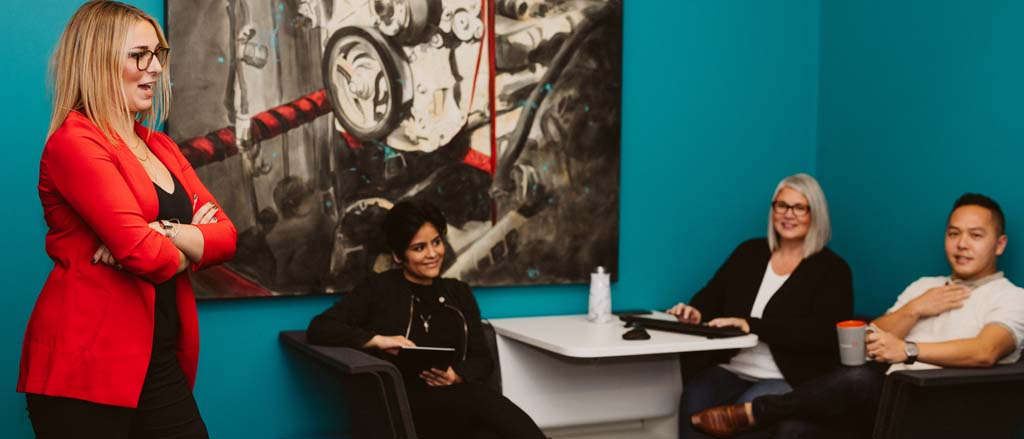
Recruitment and retention on your mind? Let’s talk reskilling
“The Great Resignation.” “Quiet firing.” “Boomerang employees.”
Feel like you’ve heard enough HR buzzwords for a lifetime? Yep, us too. But there’s one word that seems to have been steadily growing in popularity, and for good reason - many are counting it among the most important areas of focus for employers in 2023.
The concept on everyone’s mind: reskilling.
We sat down with two members of our dedicated Learning & Development team to figure out what it is, why it matters (especially now!), and how leaders and businesses can embrace it to create more flexible, knowledgeable and engaged teams.
theWorks: All right, first things first - what does “reskilling” actually mean?

Trina Huntley, Learning & Development Manager: To me, re-skilling means learning a new set of skills in order to perform a different job, enhance your skill set, or even move into a new role within your current organization. We can also look at it through the lens of preparing an organization and its employees for business transformation. Reskilling committed employees supports their personal growth and creates a highly active and engaged learner.

Maddison Kowalczuk, Learning & Development Human Resources Specialist: I’ve also seen the terms “reskilling” and “upskilling” used interchangeably, but let’s set the record straight! While both of these terms indicate that new skills are being learned, there’s some differentiation in intention. “Upskilling” is teaching somebody skills that they can use in their current role or for linear advancement. “Reskilling” is preparing somebody for a new role altogether - for example, a Service Representative learning new skills with the goal of becoming a Developer.
tW: It sounds like reskilling isn’t necessarily a new concept… but maybe one that’s getting a bit more attention these days. Why do you think it’s important for businesses to be aware of it, especially now?
TH: From my perspective, this is a time-worn concept that’s getting more attention now than ever before because of shifts in employee expectations that are here to stay! Employees have a high desire for “person-first” experiences; essentially, they want to be seen as a person, not just an employee. As a result, the best way to drive engagement and active learning is to develop employees as people and not just professionals.
These employee expectations are influencing recruitment and retention for many organizations, which pushes them to take a new approach to nurturing the learning ecosystem by investing in Learning & Development.
MK: I agree with Trina - while the idea isn’t new, it’s definitely amplified and is transforming, and the nuance of it is shifting.
I think that, in so many ways, the COVID-19 pandemic has shifted humans to move towards spaces and experiences where they find the most meaning… whether that’s reclaiming work-life harmony or moving into a new role or industry about which they’re passionate.
Ultimately, reskilling is an opportunity for reinvention, and that’s something many of us are finding especially exciting these days!
tW: How can people leaders and organizations create an environment where reskilling is not only available, but a key part of the employee experience?
1. Inspire your employees by leading by example
TH: Employers can take a more human-centric approach in supporting their employees’ expectations and ambitions by leading in a way that drives a clear sense of purpose (being authentic) while also protecting their employees’ holistic well-being (being empathetic). They should also ensure that productivity is sustainable over time and make sure that employees get the support that fits their unique needs (being adaptive).
All of this sets the stage for both employers and employees to recognize and get excited about reskilling, and to be more open to change.
MK: Absolutely - demonstrating how positive (and actually necessary) change can be is key! Task mapping or time satisfaction exercises are a great way to not only figure out how work is distributed and identify areas that employees might want to explore, but also to demonstrate organizational willingness to think differently.
2. Reward curiosity and promote employee ownership of their own growth
TH: Curiosity is essential to reskilling. By their nature, curious people are inherently more open-minded to new concepts and others’ ideas and experiences, leading to greater diversity of thought. Organizations should not only encourage but also reward employee curiosity and questions!
The result will be teams who can think both broader and deeper to uncover the root causes of issues and empathetically collaborate on creative solutions.
MK: Knowing that they’re in a safe space to ask questions and express an interest in new opportunities also empowers employees to take ownership of their own growth. People leaders are there to help them identify their goals and determine their readiness to achieve those goals. These conversations should be happening regularly.
Employees may bring forward new L&D opportunities that you’ve never heard of, or wouldn’t have connected the dots on yourself, but often those are the areas where they’ll be most engaged since it was their idea in the first place!
TH: Maddi’s absolutely right. The most progressive function a leader can exercise in today's landscape is to recognize the talents of their current employees and to empower those employees to lead their own growth.
.jpg?width=469&height=313&name=PayworksStock_2022_1%20(79).jpg)
3. Provide clarity to employees on what their growth path would look like
MK: I’m a real believer in “clear is kind.” To me, it’s important for employers to foster really honest, transparent conversations with employees at the onset of their learning journey. Who’s paying for this course? What are the time commitments? Is course-related work an appropriate way to spend a workday? Are there expectations associated with the employee’s marks?
TH: I completely agree - clarity and answers to questions like these upfront will make any reskilling much more mutually positive for both employee and employer… even if it feels a little bit awkward at first.
4. Assess need… and be honest about your capacity to meet it
TH: Once you’ve got a general sense of what the next few months of reskilling could look like for an individual or group, it’s important for their people leaders and the organization to decide what’s within and outside of the current bandwidth (and budget!). And if a high-priority opportunity falls in the latter category, can the organization adjust to make it work, or would it be better to outsource it?
MK: If a business doesn’t have their own L&D team and is looking for outside resources, organizations like the Institute for Performance and Learning are a great place to start in finding a consultant. But of course, Trina and I would advocate for having a professional L&D team in-house! <laughs>
5. Set up employees for success
MK: Employees’ time has become increasingly valuable, and one way to make reskilling feel accessible and manageable is to break it into bite-sized pieces. Payworks and many other businesses have embraced microlearning - which is to say, offering up opportunities for L&D on a regular (even daily!) basis that only take a few minutes of an employees’ time.
Yes, it’ll take longer to cover the content, but it makes the process feel much more approachable, and the repetition will help employees retain the information better down the road.
TH: Employers also need to equip employees with the resources they need to learn effectively, which contributes again to nurturing a learning ecosystem as I mentioned before. This can include anything from tools and materials specific to the topic, to fostering partnerships with other subject matter experts within the organization, who can provide guidance and encouragement along the way.
Employees may also discover great insights from their colleagues on how they can reskill together to work better as a team. Because learning is passed on with experience and practice, learning through other people, having conversations, sharing knowledge through networks and knowing the right people to ask the right questions at the right time are all very valuable points in your learning journey!
Spend more time on the big picture! When employee information is organized, you can finally reduce paperwork and focus on people. Learn more: https://www.payworks.ca/solutions/human-resources.
These articles are produced by Payworks as an information service. They are not intended to substitute professional legal, regulatory, tax, or financial advice. Readers must rely on their own advisors, as applicable, for such advice.














